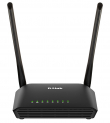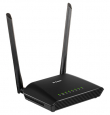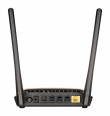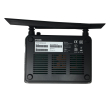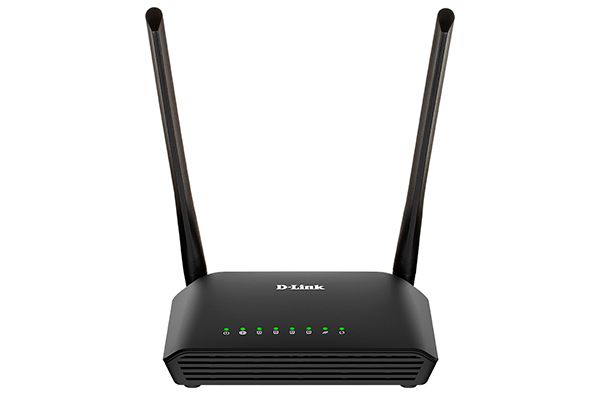
DIR-615S
Wireless N300 Router
Description
LAN/WAN Conversion
You can use any Ethernet port of the router as LAN or WAN port. The new-generation firmware supports assigning several WAN ports, for example, in order to configure the primary and backup WAN connection of different ISPs.
Wireless Interface
Using the DIR-615S device, you are able to quickly create a wireless network at home or in your office, which lets computers and mobile devices access the Internet virtually anywhere (within the operational range of your wireless network). The router can operate as a base station for connecting wireless devices of the standards 802.11b, 802.11g, and 802.11n (at the rate up to 300Mbps).
Secure Wireless Connection
The router supports multiple functions for the wireless interface: several security standards (WEP, WPA/WPA2), MAC address filtering, WPS, WMM.
In addition, the device is equipped with a button for switching the Wi-Fi network off/on. If needed, for example, when you leave home, you can easily switch the router’s WLAN by pressing the button, and devices connected to the LAN ports of the router will stay online.
Advanced Capabilities of Wireless Network
Smart adjustment of Wi-Fi clients is useful for networks based on several D-Link access points or routers – when the smart adjustment function is configured on each of them, a client always connects to the access point (router) with the highest signal level.
Support of guest Wi-Fi network allows you to create a separate wireless network with individual security settings. Devices connected to the guest network will be able to access the Internet, but will be isolated from the devices and resources of the router's LAN.
4-port Switch
The built-in 4-port switch enables you to connect Ethernet-enabled computers, game consoles, and other devices to your network.
Security
The wireless router DIR-615S includes a built-in firewall. The advanced security functions minimize threats of hacker attacks, prevent unwanted intrusions to your network, and block access to unwanted websites for users of your LAN.
Now the schedules are also implemented; they can be applied to the rules and settings of the firewall and used to reboot the router at the specified time or every specified time period and to enable/disable the wireless network and the Wi-Fi filter.
Easy configuration and update
You can configure the settings of the wireless router DIR-615S via the user-friendly web-based interface (the interface is available in several languages).
The configuration wizard allows you to quickly switch DIR-615S to one of the following modes: router (for connection to a wired or wireless ISP), access point, repeater, or client, and then configure all needed setting for operation in the selected mode in several simple steps.
Also DIR-615S supports configuration and management via mobile application for Android smartphones.
You can simply update the firmware: the router itself finds approved firmware on D-Link update server and notifies when ready to install it.
General features
|
Hardware
|
|
|
Processor
|
• MT7628NN (580MHz)
|
|
RAM
|
• 64MB, DDR2 SDRAM
|
|
Flash
|
• 8MB, SPI
|
|
Interfaces
|
• 10/100BASE-TX WAN port
• 4 10/100BASE-TX LAN ports
|
|
LEDs
|
• Power
• Internet
• 1-4 LAN LEDs
• WLAN
• WPS
|
|
Buttons
|
• POWER button to power on/power off
• RESET button to restore factory default settings
• WLAN/WPS button to set up wireless connection and enable/disable wireless network
|
|
Antenna
|
• Two external non-detachable antennas (5dBi gain)
|
|
MIMO
|
• 2 x 2
|
|
Power connector
|
• Power input connector (DC)
|
|
Mounting
|
• Desktop
|
|
Software
|
|
|
WAN connection types
|
• PPPoE
• IPv6 PPPoE
• PPPoE Dual Stack
• Static IPv4 / Dynamic IPv4
• Static IPv6 / Dynamic IPv6
• PPPoE + Static IP (PPPoE Dual Access)
• PPPoE + Dynamic IP (PPPoE Dual Access)
• PPTP/L2TP + Static IP
• PPTP/L2TP + Dynamic IP
|
|
Network functions
|
• DHCP server/relay
• Advanced configuration of built-in DHCP server
• Stateful/Stateless mode for IPv6 address assignment, IPv6 prefix delegation
• Automatic obtainment of LAN IP address (for access point/repeater/client modes)
• DNS relay
• Dynamic DNS
• Static IPv4/IPv6 routing
• IGMP Proxy
• Support of UPnP IGD
• Support of VLAN
• WAN ping respond
• Support of SIP ALG
• Support of RTSP
• Multi-WAN support
• WAN failover
• Autonegotiation of speed, duplex mode, and flow control / Manual speed and duplex mode setup for each Ethernet port
• Built-in UDPXY application
|
|
Firewall functions
|
• Network Address Translation (NAT)
• Stateful Packet Inspection (SPI)
• IPv4/IPv6 filter
• MAC filter
• URL filter
• DMZ
• Virtual servers
|
|
VPN
|
• IPsec/PPTP/L2TP/PPPoE pass-through
|
|
Management and monitoring
|
• Local and remote access to settings through TELNET/WEB (HTTP/HTTPS)
• Multilingual web-based interface for configuration and management
• Support of D-Link Assistant application for Android smartphones
• Notification on connection problems and auto redirect to settings
• Firmware update via web-based interface
• Automatic notification on new firmware version
• Saving/restoring configuration to/from file
• Support of logging to remote host
• Automatic synchronization of system time with NTP server and manual time/date setup
• Ping utility
• Traceroute utility
• TR-069 client
• SNMP agent
• Schedules for rules and settings of firewall, automatic reboot, and enabling/disabling wireless network and Wi-Fi filter
• Automatic upload of configuration file from ISP's server (Auto Provision)
|
|
Wireless Module Parameters
|
|
|
Standards
|
• IEEE 802.11b/g/n
|
|
Frequency range
The frequency range depends upon the radio frequency regulations applied in your country
|
• 2400 ~ 2483.5MHz
|
|
Wireless connection security
|
• WEP
• WPA/WPA2 (Personal/Enterprise)
• МАС filter
• WPS (PBC/PIN)
|
|
Advanced functions
|
• Support of client mode
• WMM (Wi-Fi QoS)
• Information on connected Wi-Fi clients
• Advanced settings
• Smart adjustment of Wi-Fi clients
• Guest Wi-Fi / support of MBSSID
• Periodic scan of channels, automatic switch to least loaded channel
• Autonegotiation of channel bandwidth in accordance with environment conditions (20/40 Coexistence)
• Support of STBC
|
|
Wireless connection rate
|
• IEEE 802.11b: 1, 2, 5.5, and 11Mbps
• IEEE 802.11g: 6, 9, 12, 18, 24, 36, 48, and 54Mbps
• IEEE 802.11n: from 6.5 to 300Mbps (from MCS0 to MCS15)
|
|
Transmitter output power
The maximum value of the transmitter output power depends upon the radio frequency regulations applied in your country
|
• Less than 20dBm (100mW)
|
|
Receiver sensitivity
|
• 802.11b (typical at PER = 8% at room temperature 25 °C)
-80dBm at 1Mbps
-80dBm at 2Mbps
-76dBm at 5.5Mbps
-76dBm at 11Mbps
• 802.11g (typical at PER = 10% at room temperature 25 °C)
-82dBm at 6Mbps
-81dBm at 9Mbps
-79dBm at 12Mbps
-77dBm at 18Mbps
-74dBm at 24Mbps
-70dBm at 36Mbps
-66dBm at 48Mbps
-65dBm at 54Mbps
• 802.11n (typical at PER = 10% at room temperature 25 °C)
HT20
-82dBm at MCS0
-79dBm at MCS1
-77dBm at MCS2
-74dBm at MCS3
-70dBm at MCS4
-66dBm at MCS5
-65dBm at MCS6
-64dBm at MCS7
HT40
-79dBm at MCS0
-76dBm at MCS1
-74dBm at MCS2
-71dBm at MCS3
-67dBm at MCS4
-63dBm at MCS5
-62dBm at MCS6
-61dBm at MCS7
|
|
Modulation schemes
|
• 802.11b: DQPSK, DBPSK, DSSS, and CCK
• 802.11g: BPSK, QPSK, 16QAM, 64QAM with OFDM
• 802.11n: BPSK, QPSK, 16QAM, 64QAM with OFDM
|
|
Physical Parameters
|
|
|
Dimensions (L x W x H)
|
• 141 x 100 x 32 mm (5.5 x 3.9 x 1.2 in)
|
|
Operating Environment
|
|
|
Power
|
• Output: 12V DC, 0.5A
|
|
Temperature
|
• Operating: from 0 to 40 °C
• Storage: from -20 to 65 °C
|
|
Humidity
|
• Operating: from 10% to 90% (non-condensing)
• Storage: from 5% to 95% (non-condensing)
|
|
Delivery Package
|
|
|
• Router DIR-615S
• Power adapter DC 12V/0.5A
• Ethernet cable
• “Quick Installation Guide” (brochure)
|
|
Certificates
Order info
DIR-615S/RU/B1A Wireless N300 Router
